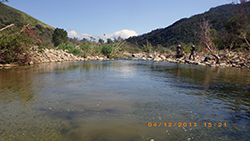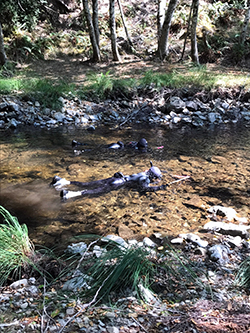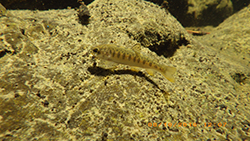
Surveying Ventura River in Ventura County

Snorkel survey in Hollow Tree Creek in Mendocino County

Hollow Tree Creek steelhead
Taking care of California’s fish and wildlife wouldn’t be possible without managing the resources upon which they depend. To that end, CDFW has an entire branch – and many scientific staff – dedicated to the scientific study, and planning and management of water resources.
Within the Water Branch, CDFW’s Instream Flow Program (IFP) is tasked with collecting and contributing data necessary to make all kinds of important management decisions about ecological function, fish rearing, spawning and migration and habitat suitability.
In the simplest terms, “instream flow” refers to the rate of the water running through a waterway in a natural environment. But when one considers all the interests competing for use of that water – fisherman, boaters, farmers, businesses, water districts, and fish and wildlife themselves – the complexity of the subject is evident.
Measured in cubic feet per second (cfs), instream flow can be measured at different times of the year in a specific location in a waterway. The fluctuations can tell scientists quite a bit about the ecosystem health of a watershed. While some watersheds have flowing water throughout the year and others are intermittent it is often the responsibility of water managers to distribute the water between uses. CDFW, a natural resource management agency, is faced with the complex task of identifying and recommending instream flows necessary for supporting natural resources. Determining instream flows are crucial so that aquatic, riparian, and terrestrial resources dependent on water will be considered and protected during water distribution activities.
Guided by the California Water Action Plan, the Public Resources Code and the Fish and Game Code, IFP staff conduct flow studies, collect field data, develop guidelines for quality assurance, conduct outreach and coordinate with other agencies and interested parties on program-related activities.
In the past year, some of IFP staff’s largest projects have included:
- A flow study at the South Fork of the Eel Watershed, which supports threatened coho, Chinook and steelhead.
- A study of 46 coastal steelhead streams (Ventura County to Siskiyou County) to develop flow criteria and evaluate historic flow trends.
- A flow study to identify flow regimes that will protect endangered Southern California steelhead in the Ventura River.
- Technical studies and final flow recommendations based upon the needs of South-Central Coast steelhead in Monterey County’s Big Sur River.
- Ongoing training for IFP staff, to ensure that field studies in swift water are carried out safely.
To learn more about these specific projects, please download the  IFP’s 2017 Year in Review (PDF) document, available on CDFW’s website.
IFP’s 2017 Year in Review (PDF) document, available on CDFW’s website.
A Featured Scientist Q&A with the IFP manager Robert Holmes is also available on the CDFW Science Institute page.
CDFW photos. Top photo: IFP staff hold a planning meeting prior to a survey on the Ventura River in Ventura County